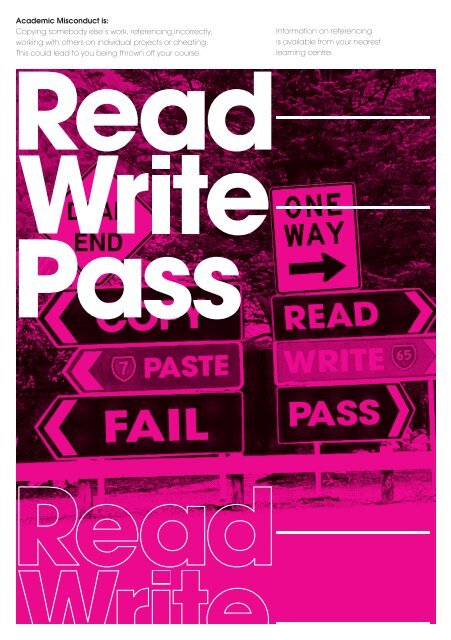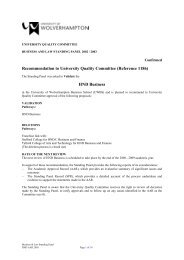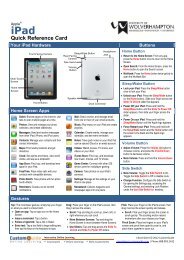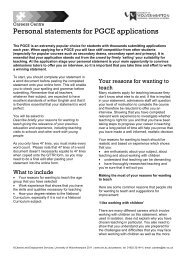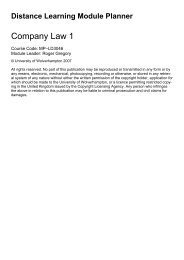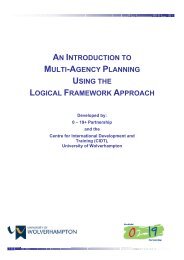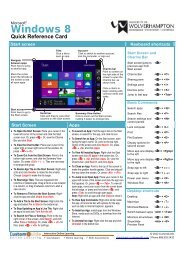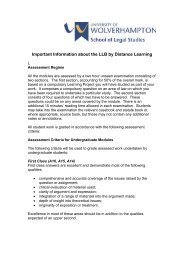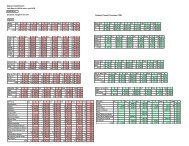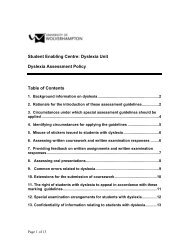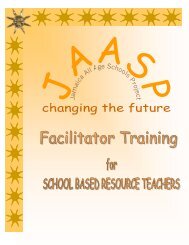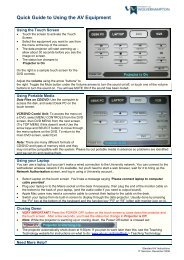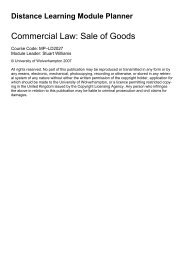Academic Misconduct Guide - University of Wolverhampton
Academic Misconduct Guide - University of Wolverhampton
Academic Misconduct Guide - University of Wolverhampton
Create successful ePaper yourself
Turn your PDF publications into a flip-book with our unique Google optimized e-Paper software.
<strong>Academic</strong> <strong>Misconduct</strong> is:Copying somebody else’s work, referencing incorrectly,working with others on individual projects or cheating.This could lead to you being thrown <strong>of</strong>f your course.Information on referencingis available from your nearestlearning centre.
ContentsPlagiarismIntroductionWhat is plagiarism?What is substantial paraphrasing?Why shouldn’t I plagiarise?Give me some examples <strong>of</strong> plagiarismHow can I avoid plagiarising?I rushed my assignment because <strong>of</strong> personal problemsHow can I develop my academic writing skills?What is Harvard referencing?How can I use Harvard referencing to avoid plagiarism?Referencing and BibliographiesPlagiarism summaryCollusionWhat is collusion?Why shouldn’t I collude?Can I copy work from other students?Give me some examples <strong>of</strong> collusionCollusion summaryCheatingWhat is cheating?Give me some examples <strong>of</strong> cheatingHow can I avoid being accused <strong>of</strong> cheating?What Extra Help Can I Get?ReferencesAppendix 1: Penalties for academic misconductAppendix 2: Referencing checklist1234567811121415161718202122232425262729
Introduction1This guide will give you the knowledgeand confidence to both avoid beingaccused <strong>of</strong> academic misconduct andimprove your assessment grades. It’s vitalthat you understand how to avoid academicmisconduct, as the maximum penalty foran <strong>of</strong>fence is exclusion from the <strong>University</strong>and ignorance <strong>of</strong> the rules is no defence.The <strong>University</strong> and the Students’ Unionbelieve that many incidents <strong>of</strong> academicmisconduct can be avoided by increasingthe knowledge and skills available tostudents. This guide, as part <strong>of</strong> the <strong>University</strong>’spolicy on tackling academic misconduct,is intended to help you understand thenature <strong>of</strong> academic misconduct, thepenalties involved and, most importantly,how you can avoid it by improving yourstudy skills.Matthew Knight<strong>Academic</strong> AdviserAdvice and Support CentreStudents’ Union
PlagiarismWhat isplagiarism?2Tutors will suspect plagiarism if it appears thatyou’ve submitted work that is not referencedcorrectly. The <strong>University</strong> <strong>of</strong> <strong>Wolverhampton</strong>’sRegulations and Procedure for the Investigation<strong>of</strong> <strong>Academic</strong> <strong>Misconduct</strong> (2007) definesplagiarism as:…the act <strong>of</strong> taking someone else’swork and passing it <strong>of</strong>f as your own.This includes incorporating eitherunattributed direct quotation(s) orsubstantial paraphrasing from thework <strong>of</strong> another/others. It is importantto cite all sources whose work hasbeen drawn on and reference themfully in accordance with the referencingstandard used in each academicschool (p1).Essentially, plagiarism is using somebodyelse’s words or ideas as your own: a kind<strong>of</strong> ‘academic theft’.The <strong>University</strong> takes plagiarism veryseriously. It’s considered as a form <strong>of</strong>academic misconduct (along withcollusion and cheating) and canattract severe academic penalties.Plagiarism can be intentional orinadvertent – but an <strong>of</strong>fence still exists.In other words, ignorance <strong>of</strong> the rules isno excuse. This is why it’s vital for youto understand how to avoid it.You cannot use other people’sideas, words, images and data inyour assignments unless you providefull details <strong>of</strong> your sources.You must acknowledge all thesources that you use by using thecorrect referencing system for yourcourse (e.g. Harvard).
Plagiarism3What issubstantialparaphrasing?Plagiarism is not just about copying andpasting from the Internet or copying directfrom journal articles or textbooks withoutreferencing. You also commit plagiarismif you ‘substantially paraphrase’ somebodyelse’s work.Substantial paraphrasing means takingsomebody’s words, without using quotationmarks, and failing to put them into your ownwords. This can catch students out.Some students may be tempted to take atext, change only a few words or the just theorder <strong>of</strong> sentences and then put a referenceat the end. Be warned! This is plagiarism inthe form <strong>of</strong> substantial paraphrasing.
PlagiarismWhy shouldn’tI plagiarise4Some students fail to see what all thefuss is about and are tempted to take theirchances. Many wish they hadn’t done soafter they’ve been through the academicmisconduct disciplinary process. This involvesyou and your work being scrutinised byan academic misconduct panel.Tutors have many ways <strong>of</strong> confirmingwhether a piece <strong>of</strong> work has beenplagiarised – for example, the <strong>University</strong>now has s<strong>of</strong>tware that can detectplagiarism. Just don’t risk it.PenaltiesThe penalties for plagiarism at the <strong>University</strong><strong>of</strong> <strong>Wolverhampton</strong> range from failing thepiece <strong>of</strong> work in question through toexclusion from the <strong>University</strong> (dependingon your level <strong>of</strong> study, the nature <strong>of</strong> theplagiarism and whether you’ve committedprevious <strong>of</strong>fences).You may also have your degreedowngraded or you may fail the wholemodule that the plagiarised assessmentrelates to. See Appendix 1 for further details<strong>of</strong> the penalties for plagiarism.Other Reasons notto Plagiarise• It’s essential to maintain the academicintegrity <strong>of</strong> degrees awarded by the<strong>University</strong>. By allowing students whoplagiarise to get away with it, the<strong>University</strong> would be doing an injusticeto the majority <strong>of</strong> hardworking studentswho haven’t plagiarised.• Referencing correctly shows that you’veresearched the topic well. If the referencingis poor, it’s likely that the content <strong>of</strong> thework will also be poor.• Students must get used to referencing theirwork so that other researchers can quicklyaccess the ideas used. This aids the wholeresearch and learning process.• Plagiarism is morally wrong. Students whoplagiarise effectively steal other people’shard work and ideas and try to pass them<strong>of</strong>f as their own. At best it’s laziness, at worstit’s deliberate academic theft.
Plagiarism5Give me someexamples <strong>of</strong>plagiarismHere are some examples <strong>of</strong> scenarioswhere students can be accused <strong>of</strong>plagiarism. They are adapted from the<strong>University</strong> <strong>of</strong> South Australia’s Learning<strong>Guide</strong> on Avoiding Plagiarism (2005).• Expressing somebody’s ideas withoutgiving a reference. This includes ideasthat are quoted directly and those thatare expressed in your own words.• Using somebody’s exact words withoutquotation marks and a correct reference.• Expressing ideas using some <strong>of</strong> yourown words but neglecting to significantlychange the author’s original version.This is plagiarism in the form <strong>of</strong> substantialparaphrasing, even if a reference is given.• Copying and pasting from numerousdifferent sources and swapping themaround to make a full assignment.
PlagiarismHow canI avoidplagiarising?6You’re expected to back up your own wordsand ideas with support from other authors.This must be done via the referencing systemthat’s relevant to your course.Many courses across the <strong>University</strong> use theHarvard referencing system (see page 11).If you take the time to learn and use thisproperly, your chances <strong>of</strong> being accused<strong>of</strong> plagiarism will be minimal.
Plagiarism7I rushedmy assignmentbecause <strong>of</strong>personal problemsThis is never an excuse for plagiarism.You can use the extenuating circumstancesprocedure to notify the Board <strong>of</strong> any problemsthat may have affected your performance in,or ability to take, any <strong>of</strong> your assessment.Alternatively, you can take a Leave <strong>of</strong> Absence.Visit www.wolvesunion.org for further nformationand follow links to Advice and <strong>Academic</strong> Advice.
Plagiarism8How can Idevelop myacademicwriting skills?When you’re using other people’s work orideas it is important to engage with theirwork critically. You can quote, paraphrase,summarise or critically review – and then youmust provide appropriate references. Let’slook at how you can use sources both toavoid plagiarism and gain higher marks.QuotingWhen quoting directly from a source youmust use quotation marks and give theauthor’s name, the date <strong>of</strong> publication andthe page number in the main body <strong>of</strong> text.You must also provide a full reference in yourreference section. When you quote you usethe exact text that was originally written.For example:Knight argued: “It is the student’sresponsibility to ensure he or she is fullyaware <strong>of</strong> how to reference; however,universities should ensure that informationis clearly publicised in, for example, awardand module guides and that study skillssupport is readily available to all students”(Knight, 2005, p4).You can, if you wish, introduce quotationslonger than four lines with a colon, then twoempty lines, then the quotation itself indentedfive spaces from the left margin, typed withsingle spacing.You then need to include in brackets theauthor’s name, the date <strong>of</strong> publication andthe page number. You don’t have to usequotation marks for this type <strong>of</strong> quotation.Knight emphasises it is more important toprevent than punish plagiarism:It is important to apply appropriatepenalties to those who attempt to pass<strong>of</strong> the work <strong>of</strong> others as their own, but itis essential to deal with the more widespreadcourses <strong>of</strong> plagiarism: sloppyreferencing and the general lack <strong>of</strong>awareness among students about thesubtleties <strong>of</strong> substantial paraphrasing.Only then will we begin to reduce theever-increasing number <strong>of</strong> studentscaught in the plagiarism trap(Knight, 2005, p5).
It’s best not to use quotations too <strong>of</strong>ten.Using quotes is not a merely a way <strong>of</strong> fillingout your word count. You should use quotesonly to back up your own arguments orhighlight original ideas from other authors.See the section on Harvard Referencingon page 11 for further information.9SummarisingIf you can master the skill <strong>of</strong> summarising,you’ll be far less likely to be accused <strong>of</strong>plagiarism, and you’ll be showing thegenuine research and critical thinkingskills that are essential for the highergrades at university level. The essentialthing to remember is that you must expressideas in your own words if you’re not quotingdirectly. Seeing as you should not be quotingdirectly too <strong>of</strong>ten in an essay, what you writeshould be how you understand it, in yourown style <strong>of</strong> expression.Take a look at the following example.It shows an original text and a student’sattempt to paraphrase it.Original text“Plagiarism is a wide-ranging <strong>of</strong>fenceand, to avoid doubt, all universities shouldgive a definition to students <strong>of</strong> what theyregard as plagiarism. That puts both partieson an equal footing and provides anunderstanding <strong>of</strong> the ground rules in caseshere plagiarism is raised as an issue”(Evans and Gill, 2001, p90).Student’s summaryTo avoid all doubt, universities shoulddefine plagiarism to their students becauseit is a wide-ranging <strong>of</strong>fence. If they do this,both parties will be on level footing andthe ground rules in cases where plagiarismis raised will be understood (Evans andGill, 2001).Do you think this is a valid paraphrase?It isn’t, even though a reference has beenincluded. This is substantial paraphrasing –it’s too close to the original source.If you regularly use this type <strong>of</strong> summarising,you’re committing plagiarism.The best wayto avoid substantial paraphrasing is to reada whole paragraph or small section, putyour source to one side and then write inyour own words what you’ve just understood.Refer back to the source and check thatyou’ve understood the meaning andcontext. You’ve then summarised thetext in your own words.
Acceptable summaryIt is vital for universities to have a full writtenpolicy on what they believe constitutesplagiarism. This way, universities will makesure students are aware <strong>of</strong> what is expected<strong>of</strong> them and the same rules can then beapplied to all studets to ensure fairness(Evans and Gill, 2001).10Note that in this example the context andmeaning <strong>of</strong> the original is kept but similarwords and sentences are not used.Critical evaluationQuoting and summarising are very usefulacademic skills to acquire and they will goa long way to ensuring you are not accused<strong>of</strong> academic misconduct. However, to gainhigher marks it is not enough to rely onother people’s ideas. You must engagewith the sources you are using andcritically evaluate them.A well-written piece <strong>of</strong> work is more than aseries <strong>of</strong> quotes, summaries and paraphraseslinked together. Your own opinions, backedup by evidence, need to be apparent inthe text. The Napier Business School (2006,p16) gives excellent advice in this area:• Identify common themes inarguments or schools <strong>of</strong> thoughtin the subject discipline• Show how thought in the areahas evolved• Show how you would classifydiffering arguments• Evaluate authors’ arguments andindicate any shortcomings in thosearguments, showing why you considerthem to be shortcomings• Indicate how much more workwould need to be done to be surecertain arguments are valid• Synthesise the evidence andarguments <strong>of</strong> several authorsto reach a conclusion• Show how each author differsand where they disagree witheach other
PlagiarismWhat isHarvardreferencing?11Harvard referencingHarvard referencing applies to the majority<strong>of</strong> <strong>University</strong> <strong>of</strong> <strong>Wolverhampton</strong> students.Law students are a notable exception (seeOxford Referencing on page 13). If you’reunsure what system <strong>of</strong> referencing applies toyour course, check with your course leader.Harvard referencing tipsWhen referring to an author’s work inthe body <strong>of</strong> your text, you should give theauthor’s name and the year <strong>of</strong> publicationin the following format:Knight (2005) states that cases <strong>of</strong> plagiarismare treated as academic misconductwhether they are seen as intentional or not.When you use a reference in the body<strong>of</strong> your text, you must also include a fullreference in a list <strong>of</strong> references at the end<strong>of</strong> the assignment. This type <strong>of</strong> referenceshould appear as follows:Making effective notesIt’s important to take careful notes <strong>of</strong>the references you use as you go along.This way you won’t be confused by thetime it comes to writing your referencesor bibliography. Make sure you take allthe relevant details. These will varydepending on the nature <strong>of</strong> the source.The s<strong>of</strong>tware programme Endnote is avery useful tool to help you organise yourreferences as you write an assignment.Endnote can be found on the <strong>University</strong>’swebsite: www.wlv.ac.uk/lib. Follow thelinks for study skills and referencing.Ask in the Learning Centres for furtherdetails <strong>of</strong> training courses on Endnote.It could save you a great deal <strong>of</strong> timein the long run.Knight, M. (2005) How to avoid plagiarism.1st ed., <strong>Wolverhampton</strong>: SU Press.See Appendix 2 for a checklist <strong>of</strong> whatinformation to include in different types<strong>of</strong> references.
12PlagiarismHow canI use Harvardreferencing toavoid plagiarismImagine that you’ve found the perfectsection <strong>of</strong> text to back up a point youwant to make in an assignment.Here’s an example:Within the UK, the resources availableto higher education from the state,whilst increasing in absolute terms, havediminished in relation to the number<strong>of</strong> students within higher education.Additionally, the penalties for failingto recruit students have become moresignificant – either in terms <strong>of</strong> reducedincome from the funding council,or reduced income from tuition fees(overseas students and taughtpostgraduate markets particularly).Reference:McClellend, M. (2006) PostgraduateCertificate Programme Handbook.Manchester: Association <strong>of</strong><strong>University</strong> Administrators.Quote it“Within the UK, the resources availableto higher education from the state,whilst increasing in absolute terms,have diminished in relation to the number<strong>of</strong> students within higher education.Additionally, the penalties for failingto recruit students have become moresignificant – either in terms <strong>of</strong> reducedincome from the funding council, orreduced income from tuition fees (overseasstudents and taught postgraduate marketsparticularly)” (McClellend, 2006, p101).Note the quotation marks at the beginningand end <strong>of</strong> the author’s text. Also notethe author, year <strong>of</strong> publication and pagenumber is given. This could have also beenquoted this in block format (see page 8).How can you use this section <strong>of</strong> textwithout committing plagiarism? Thefollowing are legitimate ways to usethe material cited above and theformat is adapted from Fletcher (2004).
Paraphrase, summariseand build upon itThe relative reduction in funding perstudent is compounded by penalties fornot achieving government recruitmenttargets and, as a consequence, areduction in tuition fee income. HEIs areparticularly vulnerable to changes in theoverseas and taught postgraduatemarkets (McClellend, 2006).13Note that this paragraph is in no wayidentical to the original, but the context<strong>of</strong> the original has been kept and builtupon it with the student’s own thoughts.Quote it but not word for wordAccording to McClellend (2006), “Withinthe UK, the resources available to highereducation from the state, whilst increasingin absolute terms, have diminished inrelation to the number <strong>of</strong> students withinhigher education” (p101). HEIs are also indanger <strong>of</strong> losing out on funding if they fail tomeet recruitment targets “either in terms <strong>of</strong>reduced income from the funding council orreduced income from tuition fees (overseasstudents and taught postgraduate marketsparticularly)” (McClellend, 2006, p101).Note how the quotes have been interwovenwith the student’s own words. Be carefulwhen doing this! It breaks up the flow <strong>of</strong> textso choose only quotes that strongly reinforceyour own arguments.Let your reader know thatyou’re aware <strong>of</strong> the materialand that it has helped t<strong>of</strong>orm your argumentThere has been plenty <strong>of</strong> research to showhow universities are experiencing an overallreduction in funding (see, for example,McClellend, 2006).Further information onHarvard referencingFor a comprehensive guide on howto use Harvard referencing, includingreferencing journals and electronic sources,please see the Learning Centre’s booklet,Harvard Style Referencing, available fromLearning Centres, the Students’ Union’sAdvice and Support Centre or online atwww.wlv.ac.uk/lib (follow the links forstudy skills and referencing).See also the referencing checklist inAppendix 2.Oxford referencingOxford referencing is used by a minority<strong>of</strong> students (e.g. Law) and differs fromHarvard referencing in that it usesfootnotes. Further information can befound at www.wlv.ac.uk/lib (followthe links for study skills and referencing).
PlagiarismReferencing& Bibliographies14Your referencing section must contain,in alphabetical order, all the sourcesthat you’ve included in your assignment.These must be laid out using the style<strong>of</strong> the referencing system used on yourcourse (for example, Harvard).Some tutors may also require abibliography in addition to or in place <strong>of</strong>a reference section. A bibliography is a list<strong>of</strong> all the sources that you’ve engaged within relation to the assignment (for example,background reading). You may not haveused all these sources in your assignment,but a bibliography shows how you haveread around the subject.
PlagiarismPlagiarismSummary15• Don’t copy directly from sources unlessyou provide fully quoted references.• Don’t rely on direct quotations to fill outyour word count.• Don’t substantially paraphrase. Makesure everything is in your own wordsunless you’re quoting direct.• Use academic skills such as quoting,summarising and critical evaluationto avoid academic misconduct andincrease your learning and overall grades.• Make sure you’re familiar with thereferencing system used on your course.• If you need help with referencing, makean appointment with a Study Skills Adviserat one <strong>of</strong> the Learning Centres (see WhatExtra Help Can I Get?).
CollusionWhat iscollusion?16Tutors will suspect collusion if two or more verysimilar pieces <strong>of</strong> work have been submitted.The <strong>University</strong>’s Regulations and Procedurefor the Investigation <strong>of</strong> <strong>Academic</strong> Conductstates that collusion occurs when...“…two or more people combine toproduce a piece <strong>of</strong> work for assessmentthat is passed <strong>of</strong>f as the work <strong>of</strong> onestudent alone. The work may be so alikein content, wording and structure that thesimilarity goes beyond what might havebeen coincidence. For example - whereone student has copied the work <strong>of</strong> another,or where a joint effort has taken place inproducing what should have beenan individual effort” (p1).
CollusionWhy shouldn’tI collude?17PenaltiesThe penalties for collusion at the<strong>University</strong> <strong>of</strong> <strong>Wolverhampton</strong> rangefrom failing the piece <strong>of</strong> work through toexclusion from the <strong>University</strong> (dependingon your level <strong>of</strong> study, the nature <strong>of</strong> thecollusion and whether you havecommitted previous <strong>of</strong>fences).You may also have your degreedowngraded or you may fail thewhole module that the collusion relatesto. See Appendix 1 for further details<strong>of</strong> the penalties for collusion.Other reasons not to collude• It’s essential to maintain the academicintegrity <strong>of</strong> degrees awarded by the<strong>University</strong>. Can you imagine being treatedby a nurse who had qualified by submittingthe work <strong>of</strong> other students?• By allowing students who collude to getaway with it, the <strong>University</strong> would be doingan injustice to the majority <strong>of</strong> studentswho have worked hard on their own.• This is your degree, not someone else’s.It’s your name that will appear on yourdegree certificate. Therefore, you haveto put the work in.• You will gain essential research,organisation and motivation skills fromindependent learning that will be invaluableto you in your future employment.
CollusionCan I copywork fromother students?18Copying from other students is neveracceptable. The rest <strong>of</strong> this sectioncontains very useful advice adapted fromNapier <strong>University</strong> Business School’s (2006,p5-6) guidelines for students.My friend said I coulduse his work…This is never acceptable and willbe penalised.• The penalty can apply to the studentwho has copied AND the student whohas provided the work to be copied.• If your friends ask you how to approachan assignment and you give them a copy<strong>of</strong> your work, the chances are they willcopy it, even if they claim they won’t.YOU and the other student(s) can bepenalised if this happens.• However, discussing your work and ideaswith others after you’ve all received yourresults may help with deeper understandingand revision <strong>of</strong> the topic. This is acceptableand encouraged but you must not, forexample, jointly produce model answers toexam questions based on these discussions.• You can critically evaluate previousstudents’unpublished dissertations,but you must provide the appropriatereferences in your work.I took my friend’s work withouther knowing…Copying from another student withouttheir consent will be treated as seriousacademic misconduct and is likely tolead to your exclusion from the <strong>University</strong>or the downgrading <strong>of</strong> your degree.Help to ensure other students don’t copyyour work by avoiding the following:• Saving your work on a hard drive <strong>of</strong> acomputer where other students mayhave access to it.• Losing a disk or USB drive, or leaving aprinted copy <strong>of</strong> your assignment whereother students may find it.• Asking someone else to submit yourassignment for you, especially if you arehanding it in advance <strong>of</strong> the deadline.• Showing your work to other students
19In the above situations the student whosework has been stolen will also be accused <strong>of</strong>collusion. The onus will be on BOTH studentsto prove what has happened. If you believeyour work has been stolen, contact yourmodule leader straight away.But my friends and I liketo share ideas…Sharing ideas with others is <strong>of</strong>ten an excellentway to learn, as you can bounce ideas <strong>of</strong>feach other and find alternative points <strong>of</strong> viewthat you wouldn’t have thought <strong>of</strong> yourself.However, there’s a fine line betweensharing ideas in this manner and colluding.If you produce common ideas, commonstructures or common words and quotes,then you make it more likely that yourassignments will be seen as similar, andtherefore more likely that you, and the rest<strong>of</strong> your group, will be penalised for collusion.Similarity in assignments would not occur ifyou studied independently.about what research to use, but you shouldbe 100 per cent confident that your work isdifferent from their work. Don’t, for example,use similar quotes or structures to your friends.Group workGroup work is a reality <strong>of</strong> working life andis seen by many module leaders as animportant part <strong>of</strong> learning. When workingon individual assessments, however, it’s vitalthat you work alone and that the work youproduce hasn’t been seen or discussedin detail with another student.If you’re in any doubt about whether ornot you should be working in a group,contact your module leader in goodtime before the deadline.To avoid this make sure you always write yourassignments up on your own, away from yourfriends. There’s nothing wrong with discussingpoints with your friends, or even sharing ideas
CollusionGive mesome examples<strong>of</strong> collusion.20The following scenarios are adapted fromChris Rook’s (2007, p1) guide for Computingstudents at the <strong>University</strong> <strong>of</strong> Northumbria.Example 1Student A has trouble with a part <strong>of</strong> anassignment and asks student B for help.Student B shows his assignment to studentA to demonstrate how he’s tackled theassignment. Student A takes notes andadds them to his own assignment. Bothstudents are finalists with no previous record.This is collusion and student A will be failthe module and have to come back thefollowing year to retake it. The retake will becapped at D5 and student A will have topay tuition fees for this module. Student Bwill receive a warning. But BOTH studentscould be penalised if there is evidencethat student B knew student A was goingto copy his work.Example 2Student C and student D sit side-by-side on<strong>University</strong> computers and knowingly use eachother’s work as they go along. They submitvery similar pieces <strong>of</strong> work. Both students arestudying at Level 2 and have committedacademic misconduct twice before.This is collusion and both students willbe excluded from the <strong>University</strong>.Example 3Student E has trouble with a conceptand asks student F for help. Student Fverbally explains some <strong>of</strong> the theoreticalprinciples that student E is having troublewith and gives advice on general sources.Both students go away and writeseparate assignments.This is acceptable and a useful processfor both students.
CollusionCollusionSummary21• You should be confident that every yoursentence <strong>of</strong> assignment is your own(unless quoting direct from another author)and you should be able to explain conceptsfully if asked to do so.• Do not show your assignments to others• If you agree to help out other students,do so by improving their understanding,not by giving them the answer. Alternatively,tell them to plan in advance and ask themodule leader, who will be happy to helpthem iron out any difficulties.
CheatingWhat isCheating?22The university takes cases <strong>of</strong> cheating veryseriously. The Regulations and Procedure forthe Investigation <strong>of</strong> <strong>Academic</strong> <strong>Misconduct</strong>defines cheating as...“…any attempt by a candidate to gainunfair advantage in an assessment bydishonest means, and includes, for example,all breaches <strong>of</strong> examination room rules,impersonating another candidate, falsifyingdata and obtaining an examination paper inadvance <strong>of</strong> its authorised release” (p1).Cheating attracts the <strong>University</strong>’s most severepenalties. It’s classed as serious misconductand if proven is likely to lead to your exclusionfrom the university or the downgrading <strong>of</strong>your degree.
CheatingGive mesome examples<strong>of</strong> cheating23Example 1Student A, an undergraduate, sits a seenexamination question and, in defiance <strong>of</strong>the exam regulations, brings in a preparedanswer. He pulls his prepared answer out<strong>of</strong> his jacket after 15 minutes and puts it onhis desk. The invigilator walks round after20 minutes and notices that student A’spaper contains far more words than astudent could be expected to write in thatamount <strong>of</strong> time.Student A’s degree class will be downgradedfrom an honours degree to an ordinarydegree for breaching exam regulations.He would be excluded from the <strong>University</strong> ifhe were studying at postgraduate level.Example 2Student B, an undergraduate, looks atstudent C’s assignment without student Cknowing, in order to steal the text and designand incorporates it into her own assignment.This is deliberate cheating, although initiallyboth students will be accused <strong>of</strong> collusion.Student B will have her honours degreedowngraded to an ordinary degree forserious misconduct, providing student Ccan show evidence that she did the workon her own (for example, by providingdrafts and study notes and being able todemonstrate knowledge <strong>of</strong> the topic).Example 3Student D, an undergraduate nurse,cannot find his supervisor in time to sign<strong>of</strong>f his practice documents. He forges hissupervisor’s signature and hands in the work.His tutor suspects he has signed it <strong>of</strong>f himself.Student D has previously been penalisedfor serious misconduct.Student D will be excluded from the <strong>University</strong>.
CheatingHow can Iavoid beingaccused<strong>of</strong> cheating?24• Familiarise yourself with the examregulations, which are availableonline at: www.wlv.ac.uk/polsregs.• Don’t take notes into an exam roomunless you have been given permission.• Don’t be tempted to cut corners byforging signatures and documents• Don’t take other students’ workand try to pass it <strong>of</strong>f as your own.• Keep all draft work and study notesso that you can show you’veworked independently.
What extrahelp canI get?25• Study Skills Advisers. Based in theLearning Centres, these advisers canhelp students with all aspects <strong>of</strong> studying.Phone 01902 322300 or book anappointment at your local LearningCentre’s reception.• See the Harvard Style Referencingbooklet, which is available from theLearning Centres, the Students’ UnionAdvice and Support Centre or online at:www.wlv.ac.uk• Endnote Training. Contact the LearningCentres (01902 322300) for details onhow this s<strong>of</strong>tware can make referencingeasy for you.• Module/Award Leaders. If you’ve got anydoubts regarding academic misconduct,contact your module leader or awardleader for clarification.• Sharpen Up Your Skills. The <strong>University</strong>runs sessions for students who wanthelp with study and personal skills.Visit: www.wlv.ac.uk/skills• Your <strong>Academic</strong> School Office canprovide you with advice on your course.• The Students’ Union’s Advice andSupport Centre is a free and confidentialservice that provides advice on academic,financial, housing and internationalstudents’ issues.Visit: www.wolvesunion.org
References26Evans, G.R., and Gill, J. (2001)Universities and Students. London:Kogan Page.Fletcher, J. (2004)Avoiding plagiarism and collusion [online].<strong>Wolverhampton</strong>,<strong>University</strong> <strong>of</strong> <strong>Wolverhampton</strong>[cited 28th July 2005].Available from World Wide Web:http://asp.wlv.ac.uk/Level7.asp?UserType=6&Level7=1152Napier Business School (2006)Plagiarism and how to avoid it –guidelines for students [online].Edinburgh: Napier <strong>University</strong>[cited 29th March 2007].<strong>University</strong> Of South Australia (2005)Learning guides: Avoiding plagiarism [online].<strong>University</strong> <strong>of</strong> South Australia[cited 28th July 2005].Available from World Wide Web:http://www.unisanet.unisa.edu.au/learningconnection/students/Lguides/!18plagiarism.rtf<strong>University</strong> <strong>of</strong> <strong>Wolverhampton</strong> (2007)Regulations and Procedure for theInvestigation <strong>of</strong> <strong>Academic</strong> <strong>Misconduct</strong> [online].<strong>Wolverhampton</strong>: <strong>University</strong> <strong>of</strong> <strong>Wolverhampton</strong>[cited 10th August 2007].Available for the World Wide Web:http://www.wlv.ac.uk/Docs/aca_acad_misc.doc.Available from the World Wide Web:http://www.napier.ac.uk/ed/plagiarism/Student<strong>Guide</strong>lines06_07.pdf.
Appendix 1Penalties foracademicmisconductPlagiarism, collusion and cheating27OffenceA first <strong>of</strong>fence committed by a studentin their first year <strong>of</strong> study on a <strong>University</strong><strong>of</strong> <strong>Wolverhampton</strong> awardPenaltyFailure <strong>of</strong> the assessment task in question(grade F0). The student will be permitted tore-sit the assessment at the next opportunityand the grade will be restricted to D5A first <strong>of</strong>fence committed by astudent not in their first year <strong>of</strong> studyOrA second <strong>of</strong>fence committed byany student on a <strong>University</strong> <strong>of</strong><strong>Wolverhampton</strong> awardFailure <strong>of</strong> the module in question (F0).The student will be permitted to retake themodule at the next opportunity and thegrade will be restricted to D5. The studentwill normally be charged for the retake.A third <strong>of</strong>fence committed by a studenton a <strong>University</strong> <strong>of</strong> <strong>Wolverhampton</strong> awardExclusion from the <strong>University</strong>.Serious <strong>of</strong>fencesSerious academic misconduct is defined as any case <strong>of</strong> deliberate, premeditatedcheating, which has either been admitted by a student, or which a panel has judgedto be a premeditated attempt to deceive and gain unfair advantage. For example –theft <strong>of</strong> another student’s work or cheating in an examination.
Appendix 1Penalties foracademicmisconductPlagiarism, collusion and cheating28OffenceFirst serious <strong>of</strong>fenceat undergraduate levelPenaltyRestriction <strong>of</strong> the awarda student can ultimately achieveSecond serious <strong>of</strong>fenceat undergraduate levelExclusion from the <strong>University</strong>First serious <strong>of</strong>fenceat postgraduate levelExclusion from the <strong>University</strong>In cases where students are excluded from the <strong>University</strong>, they will receive the award towhich they were entitled to at the time <strong>of</strong> the exclusion. For example – instead <strong>of</strong> receivinga BA (Hons) degree, an excluded student may be entitled to a Certificate in HE, a Diplomain HE or an Ordinary Degree, depending on the credit achieved at the time <strong>of</strong> exclusion.For the <strong>University</strong>’s full regulations on academic misconduct visit: www.wlv.ac.uk/polsregs
Appendix 2Referencingchecklist*29AuthorYear <strong>of</strong> publicationTitle <strong>of</strong> article/chapterTitle <strong>of</strong> publicationIssue informationPlace <strong>of</strong> publicationPublisherEditionPage numberURLDate accessedBookChapterfrom bookJournalarticleElectronicjournalarticleInternetNewspaperarticle*Taken from Napier Business School’s “Plagiarism and how to avoid it – guidelines forstudents” (2006, p27), which was adapted from Pears, R. and Shield, G. (2004) “Citethem right: referencing made easy”, Northumbria Press


